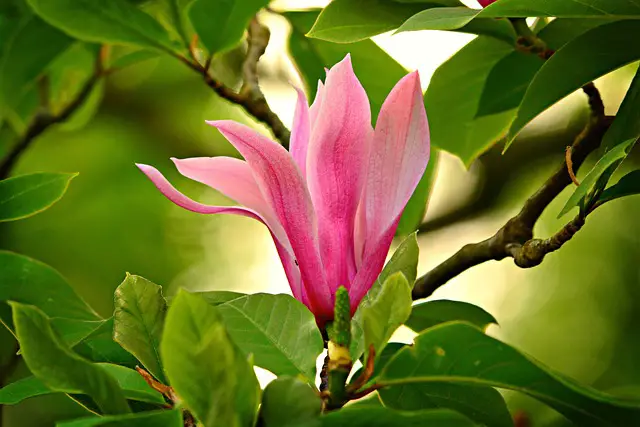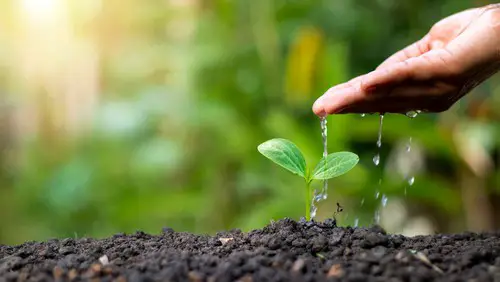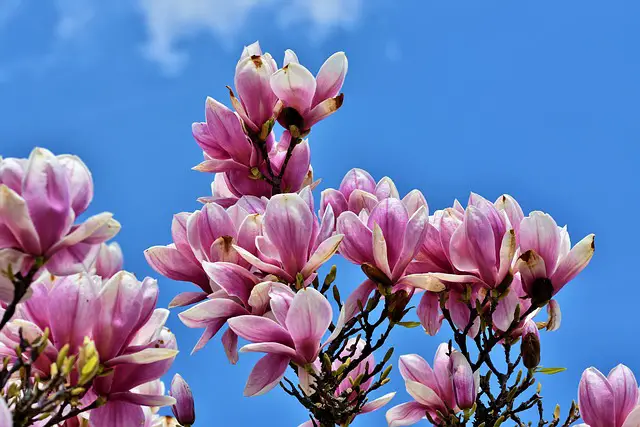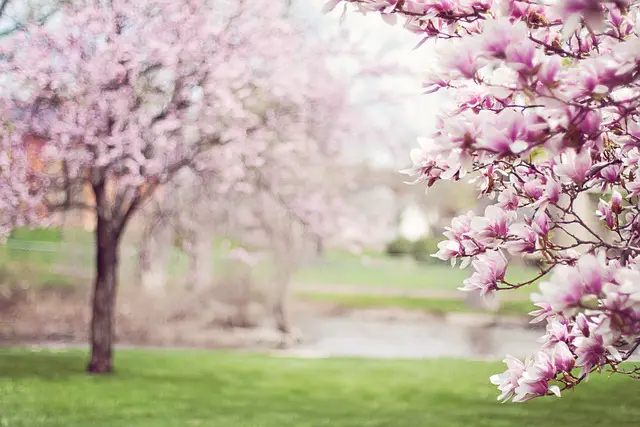Magnolia trees are a popular choice for homeowners who want to add a touch of elegance to their yard. These trees boast large, fragrant flowers and glossy green leaves that provide shade during hot summer days.
However, it can be concerning when to notice your Magnolia leaves turning brown. In this article, we will explore the reasons why magnolia leaves turn brown and what you can do to prevent it.
Understanding Magnolia Trees Magnolia trees are known for their large, leathery leaves that are dark green on top and fuzzy brown on the bottom. They are native to Asia and North America and can grow up to 80 feet tall. Magnolia trees are relatively low maintenance, but they do require proper care to keep them healthy.
Identifying Brown Leaves Brown leaves on a magnolia tree can be an indication that something is wrong. It is important to identify the cause of the problem so that you can take the appropriate steps to fix it. The leaves on a magnolia tree can turn brown for a variety of reasons, including disease, pests, and environmental factors.
Key Takeaways on Magnolia Leaves Turning Brown
- Brown leaves on a magnolia tree can be a sign of a problem.
- There are several common causes of brown leaves, including disease, pests, and environmental factors.
- Proper care and maintenance can help prevent brown leaves on a magnolia tree.
See these other top posts:
- Why Are My Ivy Leaves Turning Brown?
- Why Are My Dahlia Leaves Turning Brown?
- Why Are My Coral Bells Turning Brown?
Understanding Magnolia Trees

Magnolias are beautiful and popular trees that can add a touch of elegance to any landscape. They are known for their large, fragrant flowers and glossy, dark green leaves. Magnolias can be either evergreen or deciduous, depending on the species.
Evergreen magnolias, such as Magnolia grandiflora, keep their leaves year-round, while deciduous magnolias, such as Magnolia stellata, lose their leaves in the fall. Magnolias can grow up to 80 feet tall and 50 feet wide, making them a substantial addition to any garden.
Magnolias prefer well-drained soil and partial shade, but they can also grow in full sun. They are generally low-maintenance trees but can be susceptible to certain diseases and pests.
It is important to note that magnolias can be sensitive to environmental changes and may experience leaf browning for various reasons. Understanding the causes of magnolia leaf browning can help you take appropriate action to keep your tree healthy and beautiful.
Identifying Brown Leaves
If you have noticed that the leaves on your magnolia tree are turning brown, it is important to identify the cause of this issue.
Brown leaves on magnolia trees can be caused by a variety of factors, including frost damage, insufficient water, nutritional deficiency, disease, and pest infestations. Identifying the cause of your magnolia leaves turning brown is the first step in treating the problem and restoring the health of your tree.
Symptoms and Signs
The symptoms and signs of brown magnolia leaves can vary depending on the underlying cause. In general, brown leaves on a magnolia tree will appear dry, brittle, and withered.
The leaves may also curl up or drop off the tree prematurely. If the brown leaves are caused by a disease or pest infestation, you may notice other symptoms, such as spots on the leaves, webbing, or visible insects.
Photos and Visual Guides
If you are not sure what is causing your magnolia leaves to turn brown, it can be helpful to look at photos and visual guides. Many gardening and tree care websites offer detailed photos and descriptions of common magnolia tree problems, including brown leaves.
By comparing the symptoms and signs of your tree to these visual guides, you may be able to identify the cause of the problem and take appropriate action.
Magnolia Leaves Turning Brown – 3 Common Problems
Magnolia trees are known for their beautiful, glossy green leaves. However, brown leaves on magnolia trees are a common problem that gardeners face. Brown leaves on magnolia trees could result from several factors, such as soil and water conditions, diseases and pests, and weather and environmental factors.
1. Soil and Water Conditions

Magnolia trees require well-drained soil and adequate moisture to thrive. Brown leaves may indicate that the soil is too dry or too wet. Overwatering can cause the roots to suffocate, leading to root rot, while inadequate water can cause the leaves to dry out and drop off.
A soil test can help determine the pH level of the soil and identify any nutrient deficiencies. Magnolia trees require slightly acidic soil with a pH level between 5.0 and 6.5. Iron deficiency can also cause brown leaves on magnolia trees. Adding iron supplements or chelated iron to the soil can help address this issue.
2. Diseases and Pests
Magnolia trees are susceptible to several diseases and pests that can cause brown leaves. Some common diseases include leaf scorch, verticillium wilt, and bacterial infections such as Pseudomonas syringae. These diseases can cause the leaves to turn brown and drop off.
Pests such as scale and larvae can also cause brown leaves on magnolia trees. Horticultural oil or pesticide treatments can help control these pests.
3. Weather and Environmental Factors
Magnolia trees are sensitive to harsh winds, frost damage, and sunburn. Brown leaves on magnolia trees in the winter may indicate winter damage, while brown leaves in the spring may indicate cold damage. Magnolia trees planted in full sun may also experience sunburn.
Magnolia trees planted in partial shade may not receive adequate sunlight, leading to dying or older leaves turning brown and falling off. Mulching around the base of the tree can help retain moisture and regulate soil temperature.
Prevention and Treatment
Preventing magnolia leaves from turning brown requires proper care and maintenance. Regular pruning of dead or diseased branches is essential to maintain the health of the tree. Pruning should be done during the dormant season to avoid damaging the tree and to promote healthy growth.
Watering is crucial for the health of the magnolia tree. Magnolias require regular watering, especially during the first few years of growth. The soil should be kept moist but not waterlogged. Overwatering can lead to root rot and other diseases, while underwatering can cause the leaves to turn brown.
Fertilizing the magnolia tree is also important. A balanced fertilizer with equal amounts of nitrogen, phosphorus, and potassium should be applied in the spring and fall. This will provide the tree with the necessary nutrients to grow healthy and strong.
Mulching around the base of the magnolia tree can help retain moisture and regulate soil temperature. A layer of 2-3 inches of organic mulch such as wood chips or shredded bark should be applied around the base of the tree. Avoid piling the mulch against the trunk of the tree, as this can cause rot and other problems.
Regular soil testing can help determine if the magnolia tree is receiving the necessary nutrients. A soil test will provide information on the pH level, nutrient levels, and other factors that can affect the health of the tree.
Irrigation systems can also be used to water the magnolia tree. Drip irrigation systems are a great option, as they deliver water directly to the roots of the tree. This reduces water waste and helps prevent overwatering.
Pesticides and horticultural oils can be used to control pests and diseases that can cause the leaves to turn brown. However, it is important to use these products sparingly and according to the manufacturer’s instructions. Overuse of pesticides and oils can harm the tree and the environment.
When to Seek Professional Help

If the magnolia tree continues to experience brown leaves despite efforts to address the issue, it may be time to seek professional help. A professional arborist can assess the tree’s overall health and determine the underlying cause of the brown leaves.
If the cause is a disease, the arborist can recommend the appropriate treatment plan. For example, if the tree is suffering from Phyllosticta Leaf Spot, the arborist may recommend applying a fungicide to the tree’s leaves.
Pests can also be a cause of brown leaves in magnolia trees. If the arborist identifies pests as the problem, they may recommend applying an insecticide or using other pest control methods.
In some cases, a magnolia tree may be in decline or experiencing dieback, which can cause brown leaves. A professional arborist can assess the tree’s overall health and determine if this is the case. They may recommend pruning or other treatments to help the tree recover.
Frequently Asked Questions
What causes brown spots on magnolia leaves?
Brown spots on magnolia leaves could be caused by a variety of factors, including fungal diseases, insect infestations, or environmental stressors such as drought or extreme temperatures.
Fungal diseases such as leaf spot or anthracnose can cause brown spots on magnolia leaves, while insect infestations such as scale or spider mites can cause discoloration and damage to the leaves.
Environmental stressors such as drought or extreme temperatures can also cause brown spots to appear on magnolia leaves.
How do I prevent magnolia leaves from turning brown?
To prevent magnolia leaves from turning brown, it is important to provide the tree with proper care. This includes regular watering, fertilization, and pruning to remove any dead or diseased branches.
Additionally, it is important to monitor the tree for any signs of disease or insect infestation and to take prompt action to address any issues that arise.
Why do magnolia leaves turn brown on the edges?
Magnolia leaves can turn brown on the edges due to a variety of factors, including fungal diseases, insect infestations, or environmental stressors such as drought or extreme temperatures.
Fungal diseases such as leaf spot or anthracnose can cause brown edges on magnolia leaves, while insect infestations such as scale or spider mites can cause discoloration and damage to the edges of the leaves.
Environmental stressors such as drought or extreme temperatures can also cause brown edges to appear on magnolia leaves.
What causes magnolia flowers to turn brown before blooming?
Magnolia flowers can turn brown before blooming due to a variety of factors, including frost damage, insect infestations, or fungal diseases.
Frost damage can cause the flowers to turn brown and die before they have a chance to bloom, while insect infestations such as scale or spider mites can damage the flowers and cause them to turn brown.
Fungal diseases such as blossom blight can also cause the flowers to turn brown and die before they have a chance to bloom.
How can I revive a dying magnolia tree?
To revive a dying magnolia tree, it is important to identify the underlying cause of the tree’s decline and to take prompt action to address the issue.
This may involve providing the tree with proper care, such as regular watering, fertilization, and pruning, or treating the tree for any diseases or insect infestations that may be present. In some cases, it may be necessary to consult with a professional arborist for assistance.
What are the signs of a sick magnolia tree?
Signs of a sick magnolia tree can include yellowing or browning leaves, wilting or drooping branches, stunted growth, and the presence of fungal growth or insect infestations.
Additionally, the tree may exhibit signs of stress, such as reduced flowering or a general decline in overall health. If you suspect that your magnolia tree is sick, it is important to take prompt action to address any issues that may be present.

Hey, I’m Lisa and I’ve been an avid gardener for over 30 years. I love writing, talking and living in the garden! Feel free to connect with me on my socials below


